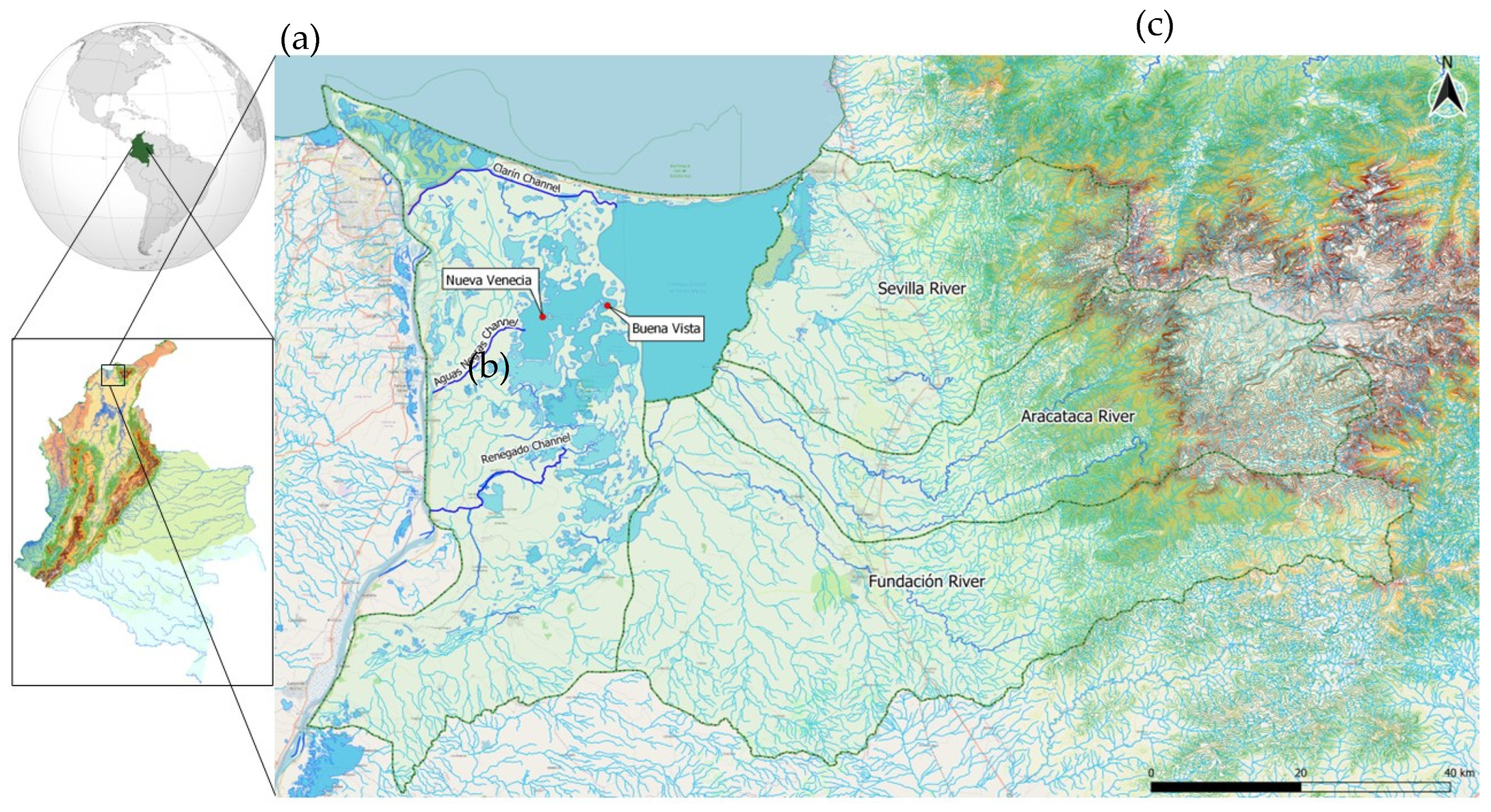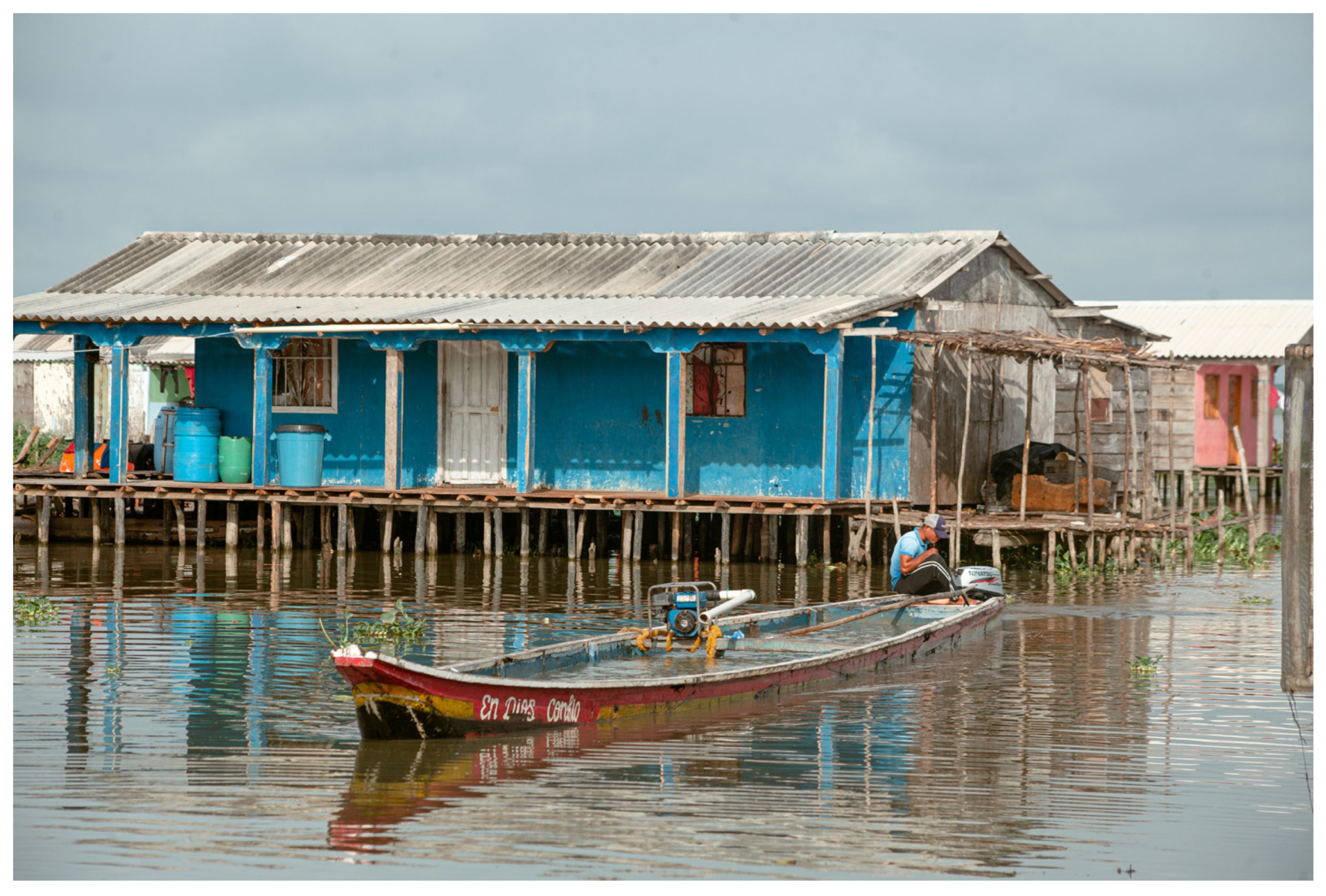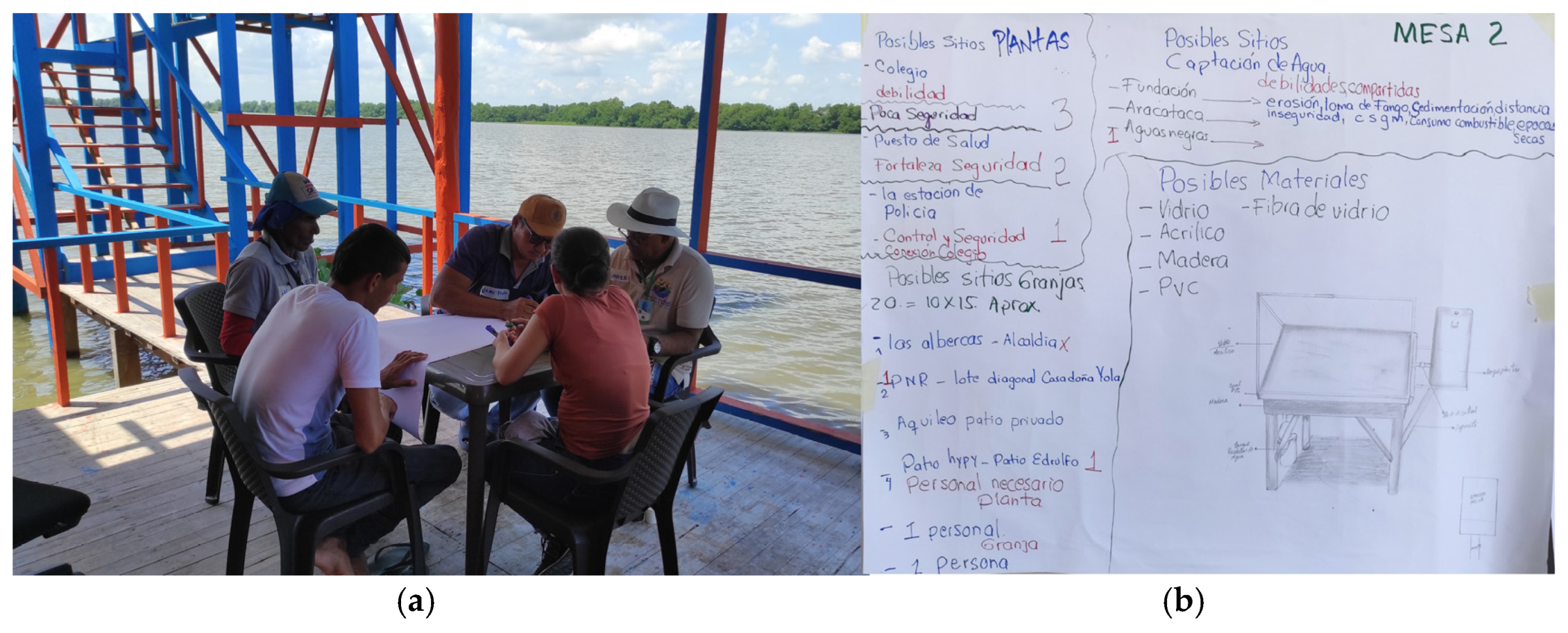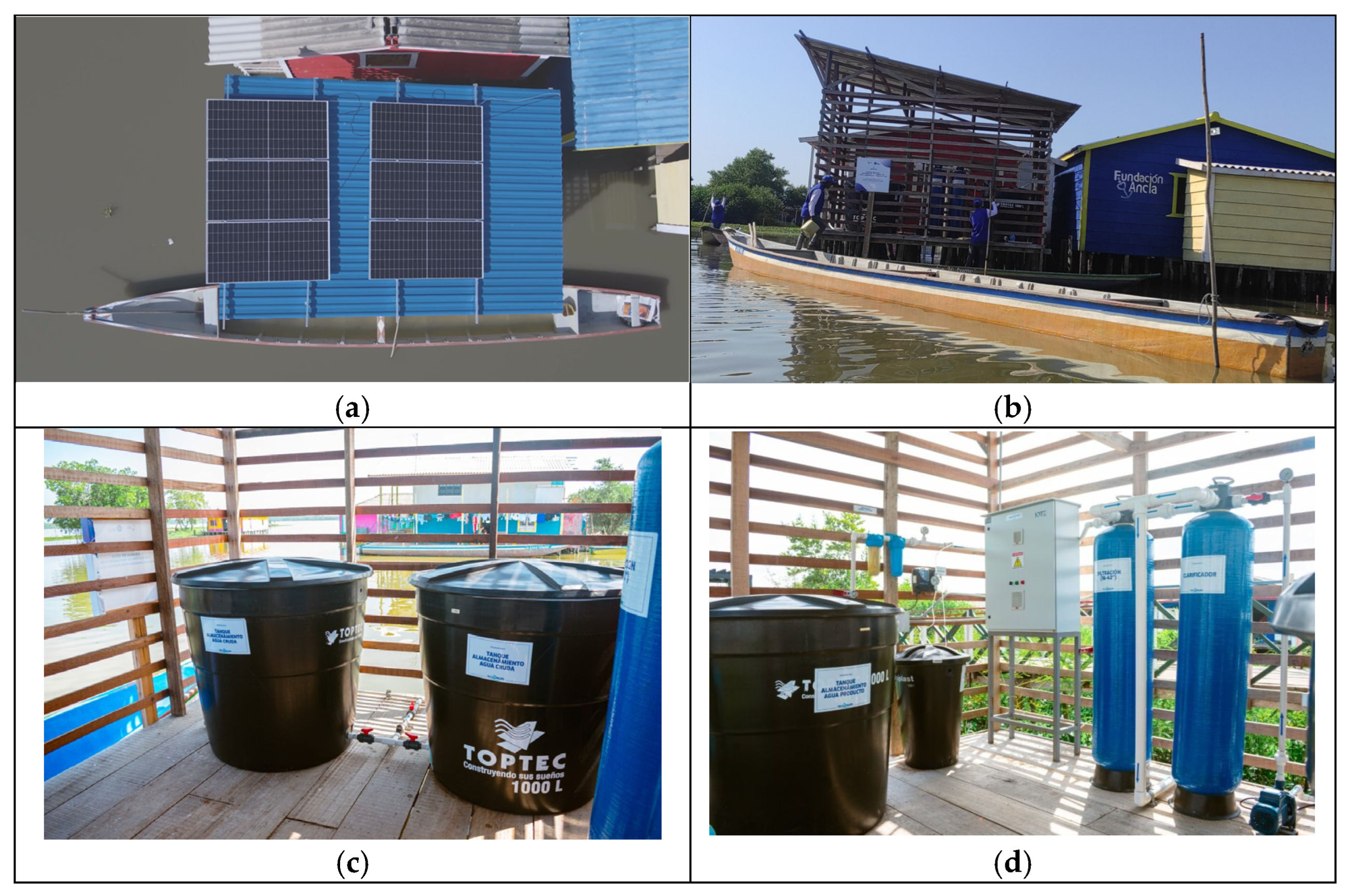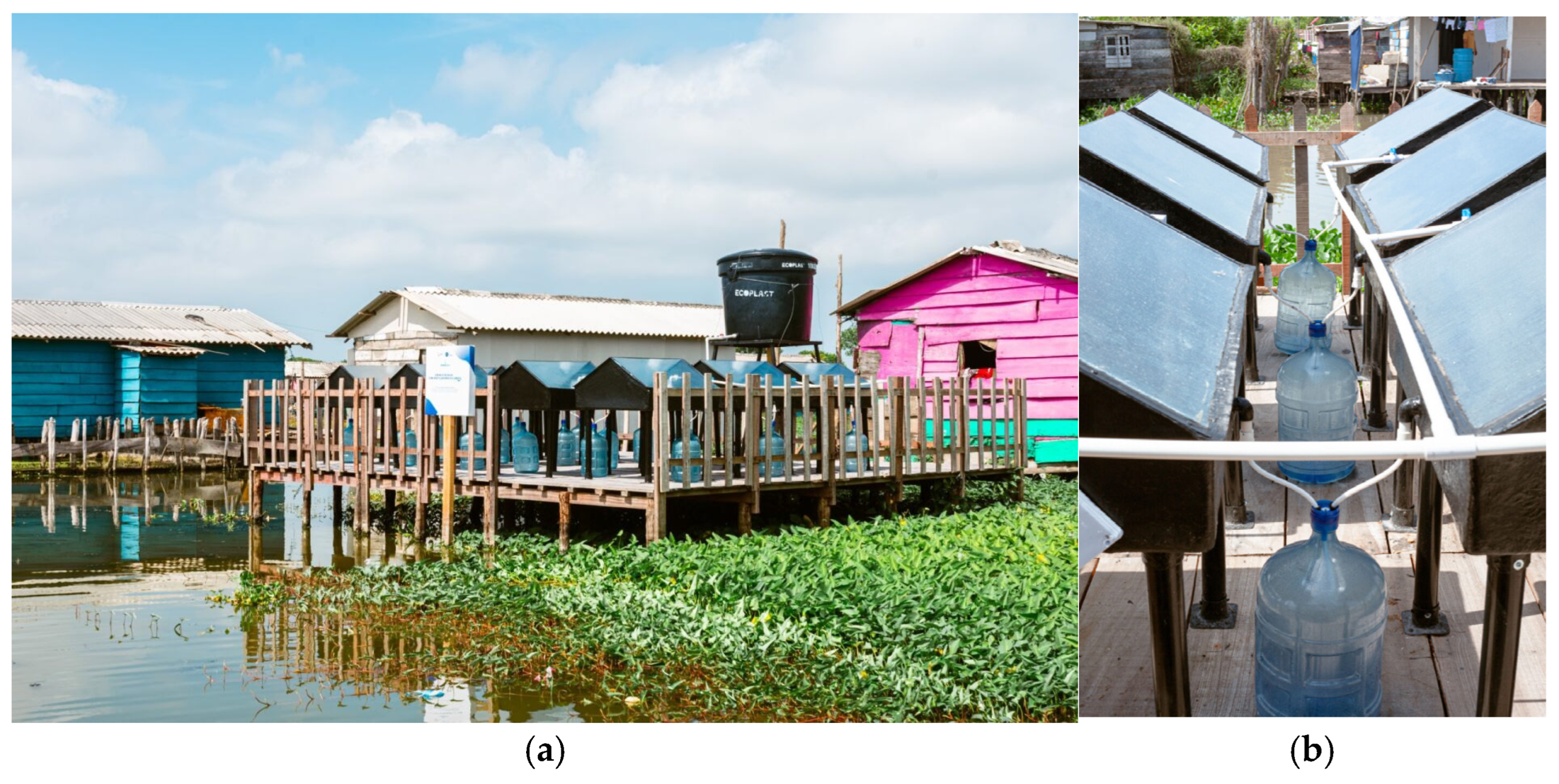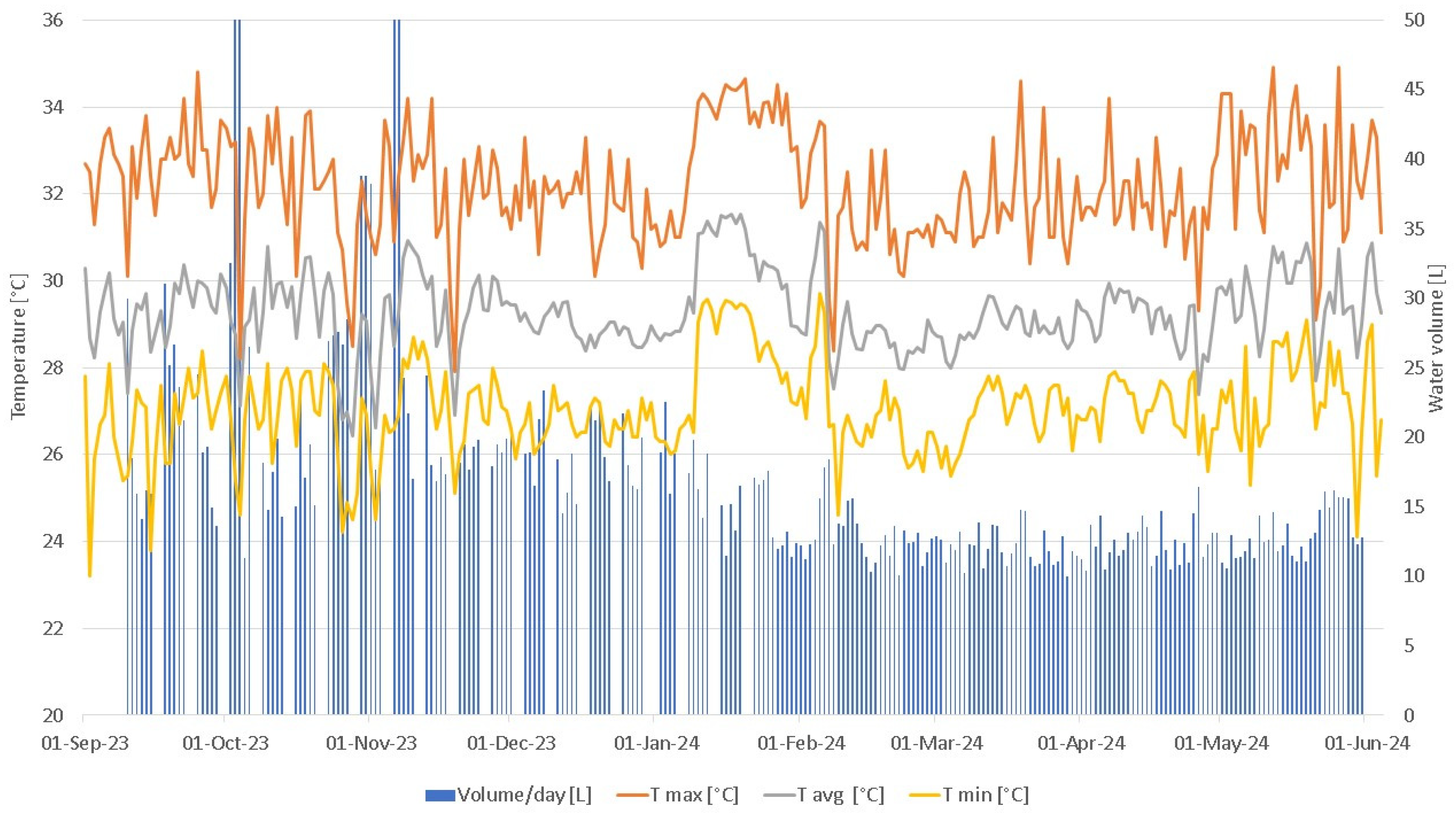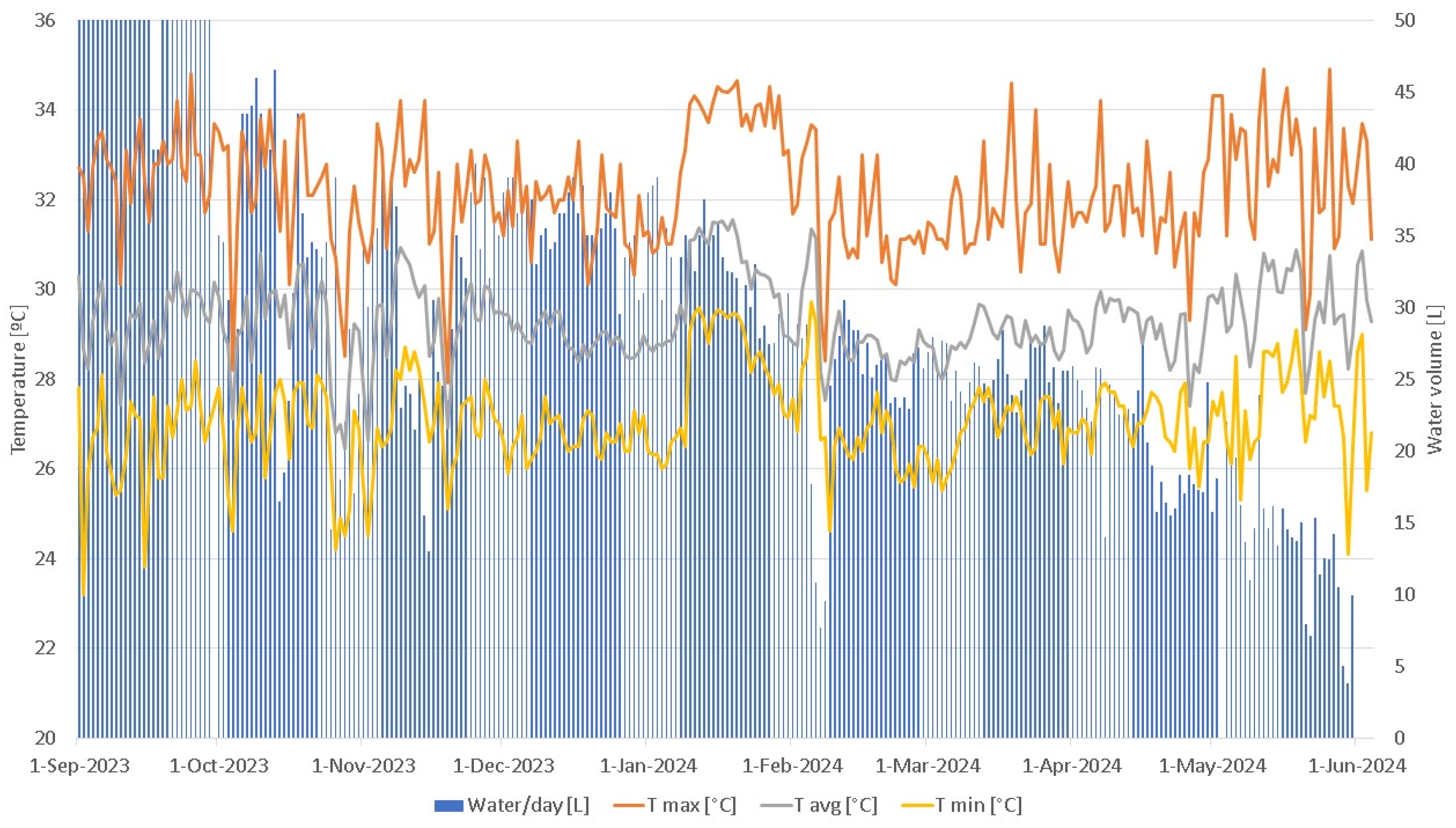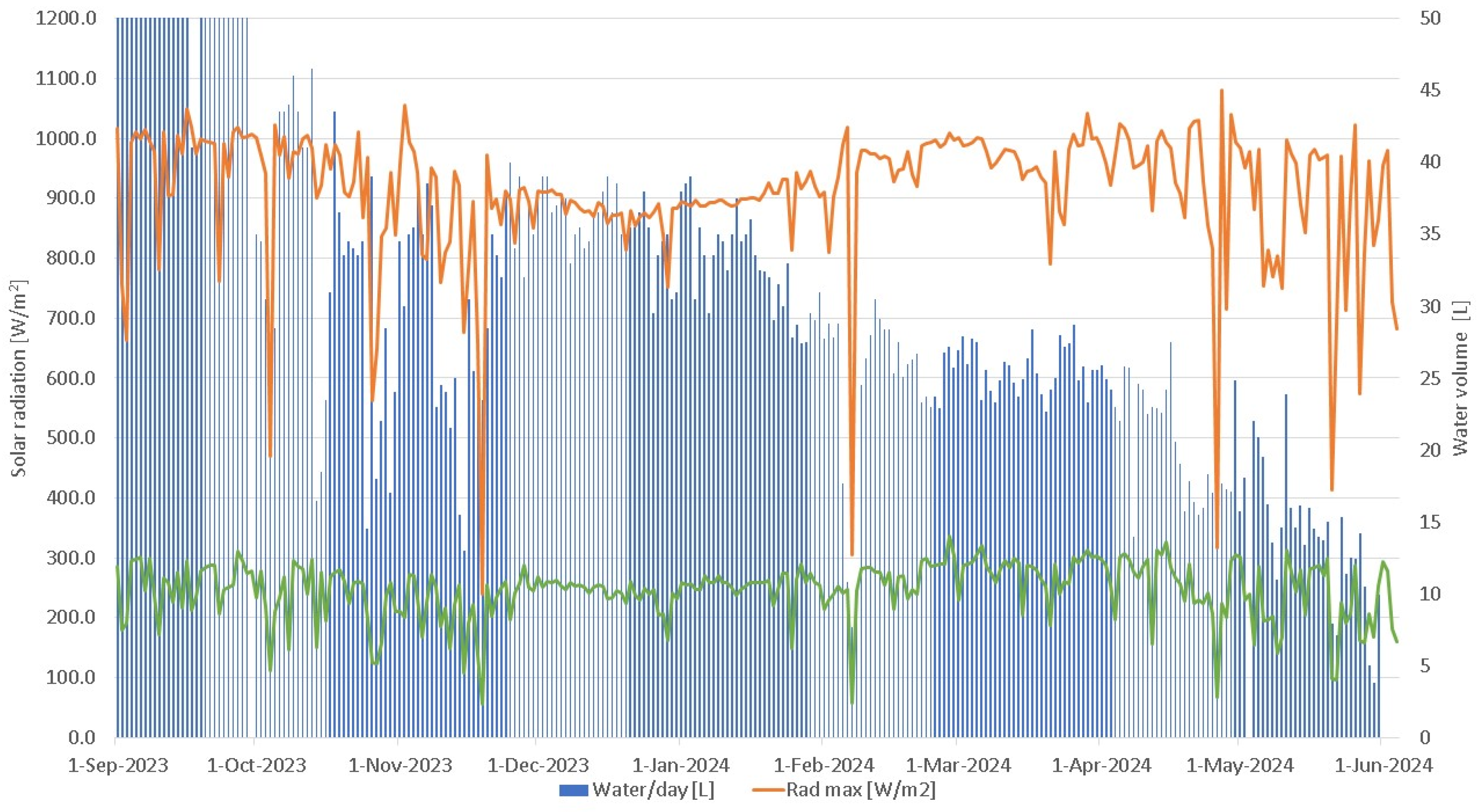1. Introduction
Mankind employs water for many purposes, such as industrial processes, agriculture, recreation, transport, commerce, and domestic use [
1]. However, due to the rapid growth of the world’s population, inefficient water management, increasing pollution, and climate change, the clean water sources present in nature have been restricted, and pressure on this resource has increased. On this planet, 3.6 million people currently lack access to safe sanitation, leading to an estimation that at least 1.4 million people die every year, many of them children [
2]. Likewise, the number of people living in urban areas with water scarcity is expected to double by 2050, reaching an estimated rate of 2.4 million people affected. In Latin America and the Caribbean, hydric stress levels increased by 15% between 2008 and 2018 [
2]. As of 2023, according to Colombia’s Ministry of Housing, City, and Territory, 12 million people have inadequate access to drinking water services, which represents 25% of the country’s population. Moreover, 3.2 million people do not have access to drinking water, an issue that is increasingly affecting rural areas.
In the local context of this study, the lack of potable water has been a constant issue in the area. The stilt house villages, amphibious settlements located within the Ciénaga Grande Santa Marta (CGSM) swamp complex, have traditionally been supplied with water from the Aracataca River and, more recently, from the Magdalena River through the Aguas Negras Canal. These waters are characterized by high and diverse levels of organic and inorganic contamination [
3,
4]. In addition, these villages lack adequate infrastructure to ensure a safe water supply for the population. As a result, a large percentage of the medical consultations in these districts’ population is related to gastrointestinal diseases, acute respiratory infections, skin diseases, and eye infections in children (Sitionuevo Mayor’s Office, personal communication).
In response to this issue of access to potable water, innovative systems for producing drinking water to satisfy the growing demand of more than 7000 million people have been extensively evaluated in several parts of the world [
5]. These solutions combine advanced technologies with sustainable approaches, including sand filtration systems [
5], biological sand filters [
6], desalination [
7,
8], rainwater harvesting, solar disinfection (SODIS), other renewable energy treatment systems [
9,
10,
11], moisture condensation from air [
12], nanomaterial-based technologies [
13], biotechnology, and phytoremediation [
14], among others. Each of these solutions has its own advantages and disadvantages, making their widespread use limited by particular climate conditions, economic and energy costs, or their inability to remove all present contaminants [
15]. However, they can be adapted to the specific needs of communities or regions depending on factors such as climate, water resource availability, energy access, and existing infrastructure.
Technologies that combine water purification with the use of renewable energy are particularly promising in addressing water scarcity in the context of climate change [
11,
16], given the close relationship between drinking water production and energy. Therefore, the solution for a sustainable future regarding these aspects involves a strong participation of renewable energies, particularly solar energy, as it shows the greatest potential. This is added to the fact that, wherever there is high hydric stress and/or scarcity, along with low levels of development, there are also good solar irradiance levels [
9]. Therefore, adequate technologies must be developed which allow utilizing solar energy to simultaneously address energy and water issues.
Nonetheless, many of these newly proposed technologies are based on treatment systems that have been tested for centuries [
15] and are not particularly novel. The real technological innovation and current challenge lie in adapting or developing decentralized systems for the needs of small communities in developing countries with very specific conditions [
17,
18,
19] and at low cost. In addressing this, Hung et al. [
15] question why the search for frugal solutions (chemistry-free, electricity-free) for potable water has not started with a universal and technologically simple solution, such as the multiple-barrier approach [
19]. Slow sand filtration systems (SSFs) and biological sand filters (BSFs) are affordable systems with high effectiveness in pathogen removal, useful for water treatment, but they are inefficient in removing chemical contamination, such as synthetic organic substances and heavy metals [
15], among others. To address this, they have been improved with other materials such as biochar [
5,
19], activated carbon [
20], iron [
6,
20,
21], and arsenic [
6], making them efficient in capturing microcontaminants such as pesticides, pharmaceuticals, industrial compounds, and chemicals. These systems are thus the best solution for decentralized systems.
On the other hand, the issue of potable water also includes the need to improve water governance, not only to strengthen managers and decision-makers in the field, as many of the resources received are not reinvested in improving infrastructure [
15], but also to empower communities to manage their own water. The systems installed must incorporate their knowledge so that they are accepted and appropriated, ultimately becoming sustainable initiatives over time. This requires an approach encompassing the entire society, including both formal and informal institutions, as the strategic integration of the interests of various contexts and interested parties leads to development of norms, standards, and methods that enhance water use efficiency and the protection of natural resources in all sectors involved [
2]. In the last two decades, water resource management has transitioned from a centralized, top-down vertical “command and control” paradigm towards a political-ecological perspective that links the hydrologic cycle on local, regional, and global scales to social, political, economic, and cultural power processes [
22]. Water then becomes a combined physical and social process typically known as the hydro-social cycle. The bottom-up hydro-social management of water is proposed both as a means to alleviate the environmental injustice faced by certain groups, such as indigenous, afro descendants, and other vulnerable communities, and to substantially improve the adaptability of existing approaches through social learning processes [
23].
Despite the advances made around the world, in Colombia, there is an imperative need for investment and technological advancement aimed at developing and applying innovative solutions to improve drinking water access and conditions and populations lacking these services or receiving them in a deficient way. To achieve this, the natural variability of water resources must be understood, as well as the specific living conditions, and the way to leverage the environment in an innovative way. Considering the settlement conditions of Nueva Venecia and Bellavista, as stilt house villages, other challenges arise in the search for tailored solutions that also take traditional knowledge into account.
Based on this, the objective of this work was to evaluate innovative and cost-effective solutions to produce drinking water for the stilt house communities of the CGSM, with the potential to impact people’s health and, consequently, their quality of life. The proposed solutions combine traditional systems with renewable energies, such as solar power, while also incorporating traditional knowledge and community water management to solve potable water supply problems. This approach recognizes the crucial role of bottom-up contributions in ensuring the sustainability of initiatives and maintaining water security for these villages located within the CGSM.
3. Materials and Methods
Technological improvements should be directed at reducing maintenance requirements and reducing costs. New decentralized designs of water treatment should also be context-specific, since system requirements differ significantly from place to place. All these criteria are important to select technology for the rural areas of developing countries where the procurement of materials is critical to achieve a sustainable water supply [
15].
To achieve the above, the ethnographic methodology was key in this process, as through fieldwork, observation, and description, a report was made on the different aspects of the community related to their customs for obtaining water and sustaining their livelihoods, as we will see below.
3.1. Traditional Water Supply Methodology—The ‘Bongoduct’
The Aguas Negras Canal is currently the main freshwater supply source of the townships of Nueva Venecia and Buenavista, by means of a traditional method adapted to the environmental, social, and economic conditions of stilt house villages. This method emerged as a form of private self-management to meet the freshwater demand of these settlements. Here, some people in the community, commonly dubbed
Aguateros [water vendors], are dedicated to collecting, transporting, and selling water, called the “Bongoduct” (
Figure 2).
Water is collected in vessels adapted for this purpose at the mouth of the Aguas Negras Canal, 2.5 km from the township of Nueva Venecia and 9 km from Buenavista. Depending on their size, the capacity of these vessels may range from 6 to 16 m3, i.e., they transport 6–16 tons of water, sometimes propelled by an outboard motor or by rowing, propelling the vessel while navigating with a wooden lever that rests on the bottom of the swamp.
Once an Aguatero reaches the water collection point, the vessel is manually filled with buckets or gasoline-powered motor pumps, which increases the vessel’s draft. After filling the vessel, the Aguatero applies aluminum sulfate to perform the coagulation, flocculation, and sedimentation processes on site, thereby supplying clarified water to the population.
The duration of the return journey depends on the vessel’s propulsion method and on wind conditions. In the case of Nueva Venecia, rowing the route can take around 1.5 h, whereas motor propulsion can take 30 min. On the other hand, in Buenavista, as it is 6 km farther, rowing may take around 4.5 h, while motor propulsion takes 1.5 h for the same route.
Upon arriving at the stilt house village, and depending on the vendor, the water is stored in tanks, which the local population can approach to buy water and transport it to their corresponding households. This service can be provided door-to-door. Here, the Aguatero is responsible for transporting and filling the storage tanks of each household to meet their needs. All these efforts are designed to meet the local demand for water, highlighting the resilience and creativity of these communities in overcoming the challenges they face.
Through ethnography, and in a concerted and participatory manner with the communities, two innovative methods were identified that can easily be integrated into local water access practices, aimed at improving the quality of the water collected in the bongoduct.
3.2. Implemented Treatment Systems
In this study, two prototype water treatment systems were implemented, which were designed and deployed with the help of the stilt house communities of the CGSM. The first of them is a conventional water treatment system that uses solar radiation as an energy source to perform the filtration, microfiltration, and chlorine disinfection processes, allowing to obtain suitable water for human consumption. The second system comprises a set of solar distillers that, through solar radiation, simulate part of the water cycle, reproducing the evaporation, condensation, and runoff processes, in order to separate any physical, chemical, and microbiological contaminants present in raw water.
3.3. Monitoring Water and Sediment Quality
With the purpose of evaluating the quality of the raw water, the treated water, and the sediments resulting from solar distillation, nine monitoring sessions were conducted, with a monthly frequency, from August 2023 to April 2024, at 10 points distributed as shown in
Table 1.
The parameters monitored in each sample corresponded to that established in current Colombian regulations regarding water. In Colombia, the admissible quality criteria to make raw water suitable for human domestic consumption and purify it only require conventional treatment, as in the case of this project. These criteria are set forth in article 2.2.3.3.9.3 of the single regulatory decree 1076 of 2015. Moreover, the quality criteria regarding the 38 physical, chemical, and microbiological parameters that must be met by water for human consumption are established in resolution 2115 of 2017.
On the other hand, quality criteria for the sediments, aimed at determining their degree of contamination or any potential hazard to the flora or fauna, have not been established in Colombia. Therefore, to analyze these aspects, the reference criteria presented in the US National Oceanic and Atmospheric Administration’s (NOAA) Screening Quick Reference Tables (SQUIRT) were used [
24].
With the established parameters, the Human Consumption Water Quality Risk Index (IRCA) was determined. The IRCA is a composite indicator through which it is possible to relate water quality and the level of risk to which a population is exposed due to non-compliance with physical, chemical, and microbiological characteristics, as established in articles 13 and 14 of resolution 2115.
3.4. Community Component
Community participation in the renewable energy sector is necessary for a better management of the territory and to exercise the right to full enjoyment of the environment in a responsible and concerted way, under the concept of bottom-up, hydro-social water management. Community participation is a right that facilitates access to other rights within a territory. Participation cannot be restricted to the application of an isolated mechanism, to a particular session, or to the elaboration of a methodological guide; it is a continuous and permanent process, deployed across all stages of a project’s development.
This way, an imperative need to enhance capabilities of local actors for effective implementation of said systems was found, as an essential complement to the roles carried by the aguateros. The development of these skills is crucial to ensure sustainability and efficiency of water management promoting a comprehensive approach that encourages collaboration and active participation of the community in improving water infrastructure.
Thus, with the purpose of assertively guiding a participatory process, and in connection with the project’s objectives, a methodological strategy for working with the communities was developed, under the modality of community worktables to promote participation, community receptivity, knowledge dialogue, and engagement with the stilt house communities during the development of the project. This methodological strategy comprised three phases: (1) a community concertation and validation activity, (2) the execution of what was concerted and validated, (3) the transfer of scientific knowledge.
During phase 1, the water treatment systems to be implemented were developed through a dialogue between scientific concepts and traditional knowledge (
Figure 3). In this way, the type of infrastructure and materials was concerted, as well as the systems’ strategic location within the villages for a greater community impact, the traditional water catchment sites, the use and prioritization of the produced water’s users, and the selection of local community supporters, an essential part of the project for operating the systems, supplying raw water, keeping records of the water produced, carrying out preventive and corrective maintenance, and delivering the treated water to the prioritized population.
In this vein, the roadmap for the execution of the subsequent phases that required community participation was also concerted, i.e., the execution of the agreements made and the transfer of knowledge for obtaining drinking water, as well as for its good handling and use.
To transfer knowledge to the communities, and especially to the community supporters, the positivist method was implemented, a philosophical movement stemming from empiricism, “which indicates that science is the knowledge of facts, of observable and measurable events”. George Berkeley, one of its main proponents, points out that the origin of knowledge is the experience of reality [
25]. In this sense, scientific knowledge was transferred by means of a hands-on experience, which, in addition to transmitting the theoretical concepts to the community supporters, focused on the in-situ development of practical experiences for handling and operation, oriented towards the effective functioning of the treatment systems.
In addition, we promoted the consolidation of a local leadership that could guide the sustainability of the project in the long term. To this effect, criteria for a differential approach in participation were incorporated, prioritizing women, considering that, as heads of household, housewives, and community mothers, they are primarily responsible for the use, handling, and rationing of water in homes. We also prioritized the youth in order to encourage leadership, as well as adult and elderly fishermen, with the aim of incorporating people with experience and knowledge regarding the local conditions of the environment and its water, in addition to its catchment, transport, and storage. Finally, we prioritized people with experience in stilt construction in order to ensure that the implemented infrastructure could support the CGSM’s environmental conditions.
4. Results
Through the merging of knowledge, water treatment systems were deployed in the stilt houses villages of Nueva Venecia and Buenavista, which were adapted to the environmental and social conditions of the CGSM lagoon complex, using solar energy and ensuring the sustainability of the initiative and the resource under the concept of bottom-up, hydro-social water management while also bolstering community leadership.
4.1. Solar-Powered Water Treatment Systems
The solar-powered water treatment systems were of the conventional type, comprising two 1000 L raw water storage tanks, 1.0 Hp centrifugal pumps, a filtration system (which included a multi-media filter composed of silica sand of different granulometries and anthracite for the removal of suspended solids, as well as activated carbon for the removal of organic and chlorinated compounds, odor, color, and residual free chlorine), an automatic chlorination system, a microfiltration system (made up of two 20 and 5 µm microfilters), and, finally, a treated water storage tank with a volume of 1000 L (
Figure 4).
The whole system was powered by six solar panels, which enabled the functioning of the pumping system and the automatic chlorine dispenser, and it was installed on the designed stilt structure.
The supply of raw water for treatment maintained the traditional culture regarding collection and transport. This means that water was collected at the Aguas Negras canal through the “Bongoduct”, and that the coagulation, flocculation, and sedimentation processes were carried out while it was transported to the solar-powered system, in order to complement the treatment.
4.2. Solar Distillers
The solar distillation water production system was composed of 121.0 m2 distillers manufactured in fiberglass, with a hermetic cover made of 4 mm thick tempered glass. These distillers were fed from a 1000 L storage tank, from which water flowed by gravity through PVC pipes.
For level control inside the distiller, a float-type valve was installed, which maintained a maximum water film of 5 cm (
Figure 5a). For distilled water collection, 18.9 L polycarbonate jugs were used, connected to the distillers by means of flexible hoses (
Figure 5b). Daily volumetric measurements were taken to determine the amount of water produced by each individual distiller and by the whole set, thereby obtaining an average daily yield value for the evaluated environmental conditions.
4.3. Amount of Water Produced
In the case of the 12 solar distillers installed in the community of Buenavista, the average daily volume of water obtained was 14.4 L, i.e., an average yield of 1.2 L day
−1 m
−2. As shown by the minimum, average, and maximum daily temperature and the water production in the Buenavista distillers (
Figure 6), as well as by the daily water production and solar irradiance values (
Figure 7), there was an inverse relationship between the volume of water produced and the temperature and solar radiation of this locality, especially during peak events of low temperature and low radiation.
For the set of 12 distillers installed in Nueva Venecia, the average daily volume obtained was 33.5 day
−1, i.e., an average yield of 2.8 L day
−1 m
−2. As seen in the figures, atypical values were reported in September, which were above 50 L day
−1. This was due to an undistilled water leak, which was repaired in October 2023. The statistics showed a direct relationship between the volume of water produced, temperature (
Figure 8), and solar irradiance (
Figure 9) in this locality.
The total volume of water produced by each system is presented in
Table 2. In the case of the solar-powered treatment plants, from 11 July 2023, to 30 April 2024, a total of 790,000 L of water was produced, with a daily average of 2000 L.
The difference in the production of the Nueva Venecia and Buenavista systems lies in the fact that, in the former, there were failures in the solar power system, which prevented operation for a few days.
Regarding the production of the solar distillers, the total amount of water produced by the two systems was 9652 L between 17 August 2023, and 30 April 2024.
4.4. Quality of the Water Produced
The IRCA of the solar-powered water treatment plants was determined using 22 of the 38 monitored parameters, as established in resolution 2115 (
Figure 10).
In the Nueva Venecia treatment plant, low risk values were observed in the samples for February and March 2024, as the residual chlorine concentrations were 0.24 and 0.25 mg L−1, respectively, considering that the established minimum is 0.3 mg L−1, according to resolution 2115.
In the case of Buenavista, low risk was observed in four of the samples, as per the parameter values found (
Table 3).
It is worth noting that the minimum residual chlorine concentration was not met. No microorganisms were present in the samples, and the necessary actions to improve the disinfection process were taken, which included raising awareness among the community’s field support personnel about the importance of preparing the chlorine solution and controlling its dosage.
In the case of the water produced by the distillers, since this type of process does not involve the use of chlorine, this indicator could not be calculated. Nevertheless, it should be added that, in some of the samples, out of the 38 physicochemical and microbiological parameters monitored, three did not meet the limits established in resolution 2115 total organic carbon (TOC), aluminum, and pH).
Table 4 presents the minimum pH value and the maximum TOC and aluminum values, in addition to the number of samples outside the acceptable range, as per resolution 2115.
4.5. Sediment Quality in the Distillers
An analysis of the heavy metal concentrations (cadmium, mercury, zinc, copper, chromium, and nickel) in the residual sediments of the distillers showed values below the detection limits (
Table 5). Therefore, they did not exceed the lowest effect level (LEL), i.e., the sediments were found to be clean to marginally contaminated. This has no effects on most of the organisms inhabiting them.
4.6. Contributions from Knowledge Exchange
The exchange between the communities and the scientists resulted in the merging of knowledge, thereby contributing to the improvement of the solar-powered systems’ effectiveness, in addition to the empowerment of the communities for self-management and a strengthened access to water, contributing to improving their quality of life.
4.6.1. Water Supply for Treatment Systems and Quality of the Water Produced
Initially, the project aimed to use the water resource from the ciénaga where the two stilt house villages are located for the water farms. However, as a result of the knowledge dialogues established with the communities during the phases of community concertation and validation, and due to local recommendations and team deliberations, it was jointly decided that the water to be used in farming would be the one traditionally used in the villages, i.e., the water pretreated with aluminum sulfate by the local Aguateros, and transported through canoes, known as “bongoduct”, in order to reduce the sediment load typically contained in it due to the material transported by the Aguas Negras canal, which comes from the Magdalena River. According to the locals’ experience, water with high sediment loads could quickly deteriorate the treatment equipment, especially considering that, in the summer season, the water tends to be salty, and the systems are not designed for desalination. In this regard, we decided to follow the local recommendations, respecting traditional knowledge and considering that the water catchment methods developed to supply the community have their own rationale and methods.
Obtaining high-quality water in optimal conditions for human consumption is considered the result of a successful ‘knowledge dialogue’, as the recommendations and experiences of the inhabitants regarding the use of pretreated water in the Bongoduct were incorporated. This resulted in a more efficient filtration system due to a lower sediment load in the raw water, thereby reducing maintenance costs and decreasing the frequency of filter backwashing.
4.6.2. Reduction of Plastics
During the implementation phase of the solar-powered treatment systems, a reduction in plastic consumption was reported, which could be considered to be the most significant positive impact on the natural ecosystem, as it reduced the need to supply water in plastic bags. Particularly in these communities, and given their geographic location, most people tend to buy packages of 100 personal water bags. In the absence of a waste management plan, these bags are discarded into the bodies of water of the natural system.
4.6.3. Community Strengthening
The transmission of scientific knowledge related to non-conventional energies to the community was implemented through the exchange of hands-on experiences, which, in addition to transmitting theoretical content, focused on developing on-site practical experiences regarding the processes of installation, handling, operation, maintenance, and monitoring of the systems. The purpose of these conceptual and procedural knowledge transfer processes was to provide skills and abilities to community supporters, aimed at the acquisition of competencies and the strengthening of their capacities as self-managers of their own development, overcoming the dependence on external actors. In this sense, there is a human team, of community origin, which is capable of carrying out follow-up, monitoring, custody, maintenance, and cleaning activities, as well as of taking daily data and typing notes, who deliver monthly reports in the form of parameter registration formats. Although the project had the limitation of being a pilot test of the effectiveness of non-conventional systems, the achievements have paved the way for a future phase of system management at the community organization level.
In a complementary manner, the consumption by the direct beneficiaries generated a positive perception of this water’s impact on improving their quality of life.
5. Discussion
In the production of water using alternative energy, solar power has been the most widely used and cost-effective, especially in desalination-based processes [
7,
26] and, to a lesser extent, when using highly contaminated water [
26,
27,
28], as is the case of this study, since the supply source was the Aguas Negras canal, derived from the Magdalena River, which extends for 1613 km, with a drainage basin spanning 257,438 km
2 [
29], collecting water from the main cities of Colombia.
Likewise, the results obtained in this study regarding water quality confirm that active solar distillation systems are efficient in water disinfection, improving water quality at a low cost and using clean energy. Particularly, these systems improve the microbiological quality of drinking water [
27,
28,
30,
31,
32], and they constitute a low-cost alternative for developing countries and rural areas. The high TOC levels and the low pH found speak to the efficiency of the system, but they imply that the methodology must be adjusted in order to ensure adequate levels for these parameters. Another limitation of the distillation-based system is the area required for installation and for reaching a production that meets the needs of the community; these systems showed an efficiency ~50 times lower than that of the solar-powered treatment plants.
The solar-powered treatment plant system, which used solar panels and a filtration system comprising a multi-media filter with pyrolusite, activated carbon, and silica sand of different granulometries, coupled with an automatic chlorination system, and employing pre-treated water obtained through the community’s traditional method, turned out to be more efficient in terms of production while also requiring less space. Moreover, this process yielded water of good quality for consumption, without the need for treatments with ultraviolet light, be it natural or induced, as in the system proposed by Khalid and Alodah [
33]. However, although this system uses the already proven efficient filtration systems improved by amendment with activated carbon and iron [
15,
20], improvements could still be introduced with the aim of reducing costs by using locally produced biochar [
5,
19], and further lowering the risk by discontinuing the use of chlorine, even though its levels were below the standard limit. This is because chlorination has the potential to generate carcinogens in the presence of natural organic matter, a common constituent in most natural waters [
15].
The experiential positivist approach with the communities and their involvement in all the stages of the process, as well as the knowledge exchange, which resulted in a merging of knowledge that facilitated and improved the initiative, confirms the proposal of Ghorbani et al. [
23]: there is a need for a shift towards a hydro-social paradigm of water management which recognizes that local needs, aspirations, and knowledge regarding the use and management of water resources are fundamental for an effective and sustainable governance in the long term.
6. Conclusions
This drinking water supply approximation, which used traditional system combined with solar energy, showed significant local environmental and socioeconomic benefits for the stilt house communities of the Ciénaga Grande de Santa Marta, thus contributing to sustainable rural development.
The merged knowledge contributed to a better design and operation of the non-conventional systems adapted to the community context, considering their articulation with the traditional forms of water supply and handling and with the use of local architecture, which led to the community’s appropriation of this kind of system, which is the most important aspect for the development of a strategy for the expansion and sustainability of the initiative to supply drinking water to the stilt house communities of the CGSM.
The use of alternative energies to obtain drinking water in the stilt house communities of the CGSM was successful, considering that it was designed, implemented, and operated with the local communities, which demonstrates that it is a fast-implementation and more cost-effective alternative in comparison with a traditional water supply system. This approach also maintains the traditional culture of supplying water through the Bongoduct, creating jobs and enabling the self-management of the community’s development, promoting the use and efficient saving of water, in addition to the reduction of the solid waste derived from the purchase of water bags or bottles.
